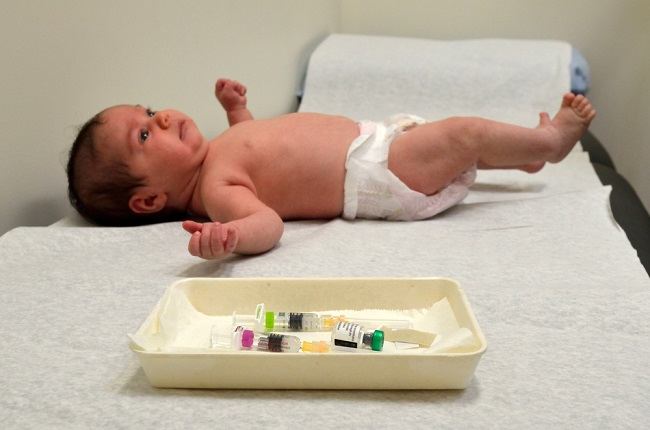Myelofibrosis is a type of bone marrow cancer that affects the body's ability to produce blood cells. This condition causes the growth of scar tissue in the bone marrow, thereby making the production of blood cells disturbed.
Patients with myelofibrosis often have no symptoms at the onset of the disease. However, as the disturbance in the production of blood cells in the bone marrow worsens, the patient will experience symptoms of anemia, such as paleness and fatigue, and easy bleeding.

Symptoms of Myelofibrosis
Symptoms of myelofibrosis are often not visible at first, so many sufferers are not aware of the appearance of this disease. However, there are some symptoms that appear when the disease progresses and begins to interfere with the production of blood cells. These symptoms include:
- Symptoms of anemia, such as fatigue, pale skin, and shortness of breath.
- Pain in the area around the ribs, because the spleen is enlarged.
- Fever.
- Frequent sweating.
- No appetite.
- Weight loss.
- Skin bruises easily.
- Nosebleed.
- Bleeding gums.
Causes of Myelofibrosis
Myelofibrosis occurs when stem cells in the bone marrow undergo mutations or changes in DNA (genes). These stem cells are supposed to have the ability to divide into some of the specialized cells that make up blood, such as red blood cells, white blood cells, and platelets.
After that, the mutated blood stem cells will replicate and divide so that more and more cells will change. This condition causes serious effects on the production of blood cells and causes the growth of scar tissue in the bone marrow.
Although often associated with mutations or gene changes, myelofibrosis is not passed down from parents.
There are several risk factors that increase the risk of this gene mutation, namely:
- Increasing AgeMyelofibrosis can affect anyone, but is most often found in people over the age of 50.
- Have a blood cell disorderPeople with blood cell disorders, such as essential thrombocythemia or polycythemia vera, may suffer from myelofibrosis.
- Exposure to certain chemicalsThe risk of myelofibrosis will increase if you are often exposed to industrial chemicals, such as toluene and benzene.
- Radiation exposurePeople who are exposed to very high levels of radiation are more at risk of developing myelofibrosis.
When to go to the doctor
Sometimes sufferers do not realize that the complaints they are experiencing are symptoms of myelofibrosis. Consult a doctor if you experience the above symptoms, especially if the symptoms do not improve.
Patients with myelofibrosis need to have regular check-ups with a hematologist. It aims to monitor the progress of the disease, as well as to anticipate and detect early complications.
Diagnosis Myelofibrosis
The doctor will start the examination by asking the patient's symptoms, then check the pulse, blood pressure, and examine the abdominal area and lymph nodes.
The physical examination is carried out to look for signs of myelofibrosis, such as pale skin due to anemia to swelling of the spleen. In addition, the doctor will also perform the following supporting examinations:
- blood testThe doctor will perform a complete blood count test to determine the number of red blood cells, white blood cells, and platelets. The suspicion of myelofibrosis will be stronger if the number of blood cells is too much or too little, and abnormally shaped blood cells are found.
- ScanAn abdominal ultrasound scan can be used to see if the spleen is enlarged or not. An enlarged spleen can be a sign of myelofibrosis.
- Bone marrow aspiration and biopsyBone marrow biopsy and aspiration are performed by taking samples of the patient's blood and bone marrow tissue using a fine needle. The tissue sample will then be examined in a laboratory to see if there is any disturbance.
- Genetic testGenetic testing is done by taking a sample of the patient's blood or bone marrow for examination in a laboratory. This examination aims to look for gene mutations in blood cells associated with myelofibrosis.
Myelofibrosis Treatment
After the patient is confirmed to have myelofibrosis, the doctor will discuss with the patient and his family about the treatment steps that need to be taken. The following treatment methods are available to treat myelofibrosis:
- Blood transfusionRegular blood transfusions can increase the number of red blood cells and relieve symptoms of anemia.
- DrugsMedications such as thalidomide and lenalidomide can help increase the number of blood cells and shrink the spleen. These drugs can be combined with corticosteroid medications.
- JAK2 drug iinhibitorJAK2 inhibitor drugs are given to slow or stop gene mutations that cause cancer cell growth.
- ChemotherapyChemotherapy is done by giving drugs to kill cancer cells. This drug can be given in tablet form or by injection.
- RadiotherapyRadiotherapy is the use of special beam radiation to kill cells. Radiotherapy is done if the spleen is enlarged. This treatment can help reduce the size of the spleen.
- Bone marrow transplantBone marrow transplant is done if myelofibrosis is very severe. This is done to replace damaged bone marrow with healthy bone marrow.
Complications Myelofibrosis
Myelofibrosis can cause serious complications if not treated immediately. Some of these complications are:
- Increased blood pressure in the veins of the liver (portal hypertension).
- Chronic back pain due to an enlarged spleen.
- The growth of tumors in certain body parts.
- Bleeding in the gastrointestinal tract.
- Myelofibrosis changes to leukemia
Myelofibrosis Prevention
Myelofibrosis cannot be prevented, but the risk can be reduced by having regular medical check-ups. That way, myelofibrosis can be detected early and can be treated immediately. Therefore, you also need to immediately see a doctor if you experience the symptoms of this disease.
Exposure to chemicals and radiation in the work environment is also at risk of causing myelofibrosis. If you work in a place that is often exposed to chemicals or radiation, use personal protective equipment that meets work safety standards and do it medical check-up employees regularly.









